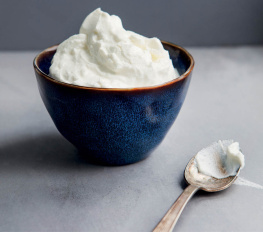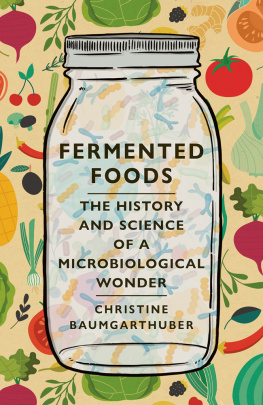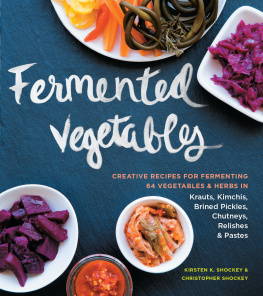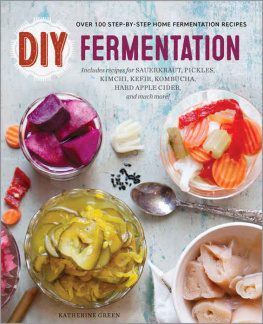Contents
Foreword
Food is life, but as Kirsten and Christopher Shockey demonstrate in this marvelous book, it is also alive. That is, food ferments. It bubbles and churns, froths and foams, releasing compounds that benefit our health. But Fiery Ferments isnt primarily about nutrition (though thats a nice bonus). The Shockeys celebrate flavor, specifically flavor that zings, and they are excellent guides into the lively world of fermentationthe wonders of microbial action, the magical transformations it achieves.
And what magic! Fiery Ferments travels the globe as the recipes progress from familiar hot sauces and salsas to condiments other cultures enjoy: Haitian pikliz, Indian achar, Indonesian rempah, Yemeni zhug. And theyre all presented in a spirit of experimentation and fun. Why stick to traditional kimchi made with cabbage when you can use nettles, green beans, summer squash, or rhubarb instead?
The late anthropologist Sidney Mintz wrote about the core-fringe pattern of eating in which bland, starchy staplesfoods like rice, potatoes, cassava, even pastaare enhanced by a fringe of condiments that stimulate the appetite by providing vibrant texture, color, and taste. No wonder the word relish refers to these condiments as well as to our pleasure in eating them.
These fringe foods and the pleasure they inspire is what Fiery Ferments is all about. After beginning with the basics of fermentation, the Shockeys usher us from kitchen to table with recipes for wonderfully innovative meals. Why season chili with a standard chili powder blend when you can use your own Fermented Green Chili Base and top the steaming bowl with homemade Habanero Carrot Sauce? Youll also discover that jalapeo poppers really pop when you begin with fermented carrot-stuffed peppers. And dont forget dessert. What better way to end a tongue-tingling meal than with chocolate -cranberry mole ice cream or Persimmon Ginger Sorbet?
Kirsten and Christopher are two of the most generous cooks I know, and the best kind of teachers. After sharing their carefully tested recipes and secret tips for success, they encourage us to experiment on our own. Im ready to take the plunge. After all, as this book amply demonstrates, fiery ferments sustain both body and soul.
Darra Goldstein Editor in Chief, CURED ( curedmagazine.com )
Be sure to read all instructions thoroughly before using any of the techniques or recipes in this book and follow all safety guidelines.
Introduction
Fiery Ferments is not just another hot sauce book.
Dont worry, there are plenty of delicious fermented hot sauce recipes in this book; if that is all you want, you will not be disappointed. However, we wanted to explore what it means to push the essence of pungency. As we researched and experimented, we discovered that there are many ways to wake up the tongue in that eye-popping, wow-what-did-I-just-taste moment. And there are a lot of people who love stimulating, flavorful food but prefer not to singe their mouths. This book is for them, too.
Humans seem to have always craved some spice in their lives and in their meals. Until very recently (if you consider the time frame of all of human history), our favorite spicy foods and condiments were likely preserved through lacto-fermentation , with all the flavor, nutrients, enzymes, vitality, and other elements of goodness that accrue from working with probiotic bacteria. Then methods of quick acidification with vinegar and pasteurization came along, and our traditional spicy foods lost their probiotic love. Yes, modern hot sauces can stand on grocery-store shelves waiting for you to buy them for a very long time and will remain safe and flavorful, but they are no longer alive.
We think its time to bring that life the fiery ferments back into our own lives. We have devoted ourselves to researching ancient accounts of meals around the world, deconstructing hot sauces and rebuilding them with new custom vegetable ferments, and doing a lot of testing on the plate. We hope you enjoy these spicy characters as we give them their seats at the head of the table. They are fun, a bit crazy, and full of flavor.
Some Like It Hot! (A Brief History)
It was once thought that spice was a modern invention, that our Stone Age ancestors had no time or appreciation for anything that didnt directly fuel their survival. But in recent years, with the help of some ancient dirty dishes, scientists have discovered a different story: this love for spice has been with us for thousands of years, and civilizations the world over have always cultivated a local version of something hot.
Stone Age Spice
When researchers from the University of York analyzed some 6, 000-year-old clay pots from Stone Age dwelling sites in Germany and Denmark, they discovered that fish and deer were eaten with ground garlic mustard (Alliaria petiolata), especially fish. When they re-created the meals, the researchers agreed that the addition of the mustard, while adding little if any nutritional fuel, did improve the flavor.
Similarly, a team of scientists at the Smithsonian Institution has been able, through the analysis of starch grains housed in their vast reference collection, to date the presence of chiles to that same Stone Age period in at least seven sites stretching from southern Peru to the Bahamas. These chiles differ slightly from the wild chile, meaning they had been cultivated by humans.
Root crops that included turmeric, ginger, and garlic show up in the archaeological record about 4,500 years ago, again in some very old pots, this time found in New Delhi. Linguistic evidence suggests that turmeric and ginger were also important to the peoples of southern China during this period: The Austronesians had begun a massive migration of thousands of miles, all the way east to Easter Island, south to New Zealand, and west to Madagascar. The ancient languages of these areas all have a word for ginger, and its the same word. Ginger was important enough to these people, who took only what they could carry, that it came with them and stayed with them.
Meanwhile, in India turmeric and native peppers were being used medicinally, as referenced in early Ayurvedic texts. This includes both black peppers and long peppers, and if you havent heard of , you will soon.
So up until a few thousand years ago, your choice of spice had everything to do with the continent you called home. If you lived in Europe, it was mustard and horseradish. If you lived in Asia, you used either black pepper and its relatives or ginger. We have some tasty recipes for these in chapter 4, our chapter devoted to recipes without chiles. If you lived in the Americas, your go-to spice was the chile. Chapters 5 and onward are devoted to recipes that showcase the versatility of this picante, mouth-singeing fruit.
The Arrival of the Chile

![Goldstein Darra Fiery Ferments [eBook - Biblioboard]: 70 Stimulating Recipes for Hot Sauces, Spicy Chutneys, Kimchis with Kick, and Other Blazing Fermented Condiments](/uploads/posts/book/201436/thumbs/goldstein-darra-fiery-ferments-ebook.jpg)












